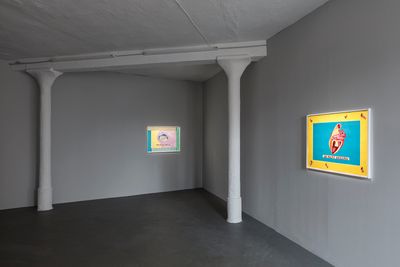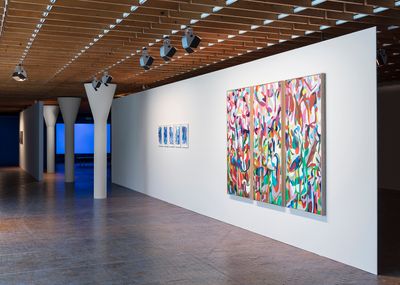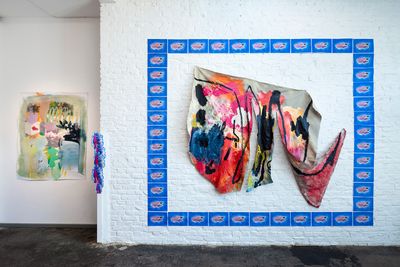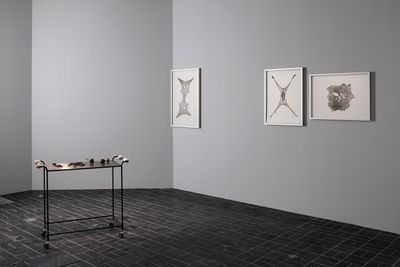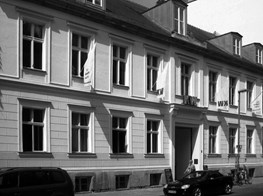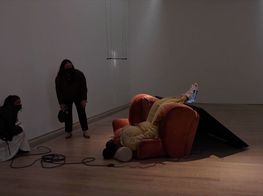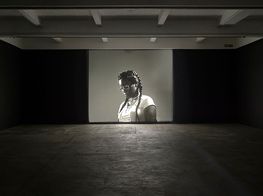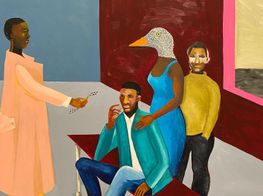10th Berlin Biennale: ‘Let’s be clear; we are at war’
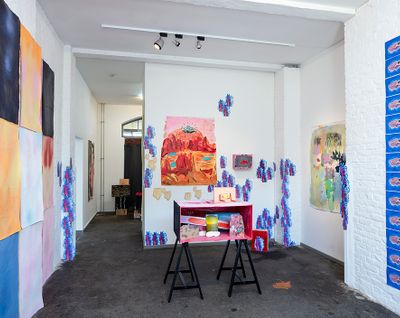
Sam Samiee, The Unfinished Copernican Revolution (2018). Mixed media. Exhibition view: We don't need another hero, 10th Berlin Biennale for Contemporary Art, ZK/U – Center for Art and Urbanistics, Berlin (9 June–9 September 2018). Courtesy the artist. Photo: Timo Ohler.
'Let's be clear; we are at war.' These were Gabi Ngcobo's defiant words at the press conference for the tenth edition of the Berlin Biennale for Contemporary Art, which she curated: We don't need another hero (9 June–9 September 2018).
This militant theme was highlighted by designer Maziyar Pahlevan, through the incorporation of dazzle camouflage patterns in the exhibition's visual identity, transforming the five venues—the usual KW Institute for Contemporary Art as well as Akademie der Künste, HAU Hebbel am Ufer, and ZK/U-Center for Art and Urbanistics—into a united fleet of warships in shades of pink and grey.
Yet, to figure out whom 'we' are at war with in this show requires us to look beyond the enemies that Ngcobo identifies in her catalogue essay—racism, sexism, homophobia and transphobia—and to instead uncover the latent forces within the art world that embody the ideas that this exhibition challenges.
There is no doubt that the political dimension of Ngcobo's exhibition is tinted with intersectional social identities, but its shades are rather camouflaged. This subdued logic can also be deducted from the title of the Biennale's public programme curated by Thiago de Paula Souza, 'I'm Not Who You Think I'm Not'—a revision of Charles Horton Cooley's famous sentence: 'Today, I'm not what I think I am; I'm not what you think I am; I am what I think you think I am.'
Drawing from the original phrases' ambiguity, 'I'm Not Who you Think I'm Not' is a paradoxical statement that speaks of a possible overlap, in the negative form, with the dominant forces that define the content of one's otherness and disengages from normative ideas about the identity of the exhibition's artists and curators.
Indeed, Heba Y. Amin's is the Biennale's rare work that deals directly with the geopolitics of the Anthropocene, marked by increasing tensions around the issues of natural resources and migration between the so-called North and South.
The Master's Tools I (2018) at Z/KU is a nine-channel video installation that sees Amin deliver a speech on one screen surrounded by a mandala of eight others showing well-known world politicians—from Egypt's Nasser to Italy's Mussolini and China's Xi Jinping—whose speeches Amin used to construct her own, as inspired by Herman Sörgel's idea of combining Africa and Europe into one continent called 'Atlantropa'.
In many ways, Amin's contribution offers a point of departure when considering the rest of the show and its aims, given the tactical use of camouflage as a way to avoid pigeon-holing artists as national or cultural ambassadors, which in turn allows for a more expanded engagement with their art.
Another work that succinctly expresses Ngcobo's curatorial intent is Dineo Seshee Bopape's installation Untitled (of Occult Instability) [Feelings] (2016–2018): both a recreation and an expansion of her 2016 debut at Palais de Tokyo that takes over the main hall of the KW.
A demolition scene features broken bricks, pipes, and other debris, with video footage from Nina Simone's famous 1976 Montreux concert, which showcased the melodic militancy typical of the late singer's politics, and scenes from a Parisian park displayed on video monitors. Within this space, four columns identical to those holding up the roof of the KW's main hall lie on the ground, while streaks of slowly dripping water fill several large plastic buckets.
Hanging from the ceiling is Discoball X (2018), a large wrecking ball made out of cardboard by Jabu Arnell, whom Bopape invited to collaborate on the installation, along with Robert Rhee, showing two gourds protruding from metal frames_, EEEERRRRGGHHHH_ and ZOUNDS (2015), and Lachell Workman's Justice for _____ (2014), which includes a slide projector presenting a single slide that reads: 'Justice For'.
The message in Bopape's scene seems unpretentious: destroy the institution from within. This missive is complemented by a collaborative work by Arnell and Sinethemba Twalo, A Kind of Black: an emergent poetics of the imminent unknown (2018), which fully occupies the KW's top floor.
Amid drastic Prussian blue lighting, a boat-like structure made from organic rope hovers above a small black sign on the floor displaying the work's main title in glowing letters.
A sense of dispersion within space, accompanied by gestures of interaction, is palpable throughout Ngcobo's exhibition. For one thing, works by several artists in the Biennale are spread out across different halls and venues instead of being presented in units.
Among them are the New Zealand artist Luke Willis Thompson's almost identical series of water fountains/urinals manufactured from bronze and ready-made components (Untitled, 2015) and Johanna Unzueta's series of geometric colour drawing/sculpture hybrids, whose dates of production range from 2015 to 2018.
Lubaina Himid is represented by nine paintings produced for the Biennale, six of which are showing at Akademie der Künste with the rest on view at KW and Z/KU.
Titled 'On the night of the full moon' (2018) the series is, as with much of her work, derived from the style of fabrics worn by East African women. Commonly called Kanga, they consist of three parts whose Swahili names are: the pindo (the border), the mji (central motif), and the jina (message).
The jina is very often either a riddle or a proverb, and Himid masterfully builds upon this pictorial and narrative tradition by intermixing it with words from poets like Audre Lorde, Maud Sulter and Essex Hemphill.
The sparse and spacious exhibition design at the Akademie der Künste transposes the modality of art fairs to the realm of critically curated biennial shows, removing the historical and political distinctions between these two modes of exhibiting contemporary art while transforming both.
It offers a leisurely walk through different artistic presentations, showing works without causing any interference as if each wall or enclave constitutes a booth.
This was particularly visible in the installation of Herman Mbamba's colourful abstractions, The blue mandane series 1–5 (2017–2018), Wait for me in the lurking landscape (2017–2018), and Until the wind blows for another time (2017–2018), as well as the mural-like triptych of monoprints on paper by Belkis Ayón, La consagración (The Consecration) I, II, III (1991), which depict an initiation ritual of an exclusively male Afro-Cuban secret society called Abakuá.
This strategy achieves a synthesis in which contemporary art can be both critical and commercially viable within a biennale setting, by making 'exposure' a gesture of re-routing attention.
Rather than predominantly supporting well-known career artists, the curator does an excellent job of creating the right spatial setting to introduce a new generation of artists from across the Global South not only to a general public, but to a specialist audience—commercial galleries and collecting institutions—who, in the future, might incorporate what they see in Berlin into existing markets and systems of display.
This is a welcome call in a curatorial world that often privileges new media, ephemeral and non-commercial practices in such contexts as these, over art that can be construed as market friendly—that is, easily collectable—mostly at the expense of artists who, after exhibiting at a round of critical shows, have to either teach at an art school, continue living precariously, or change their profession due to an inability to sustain their lives through their practice alone.
Rejecting the residual distrust against painting that emerged in the 1990s, Ngcobo offers a fresh approach to the medium, showing why curatorial strategies that continue to marginalise painters need to be questioned if not altogether abandoned.
Among many rigorous examples of contemporary approaches towards painting are Lynette Yiadom-Boakye's oil on linen polyptych A File For A Martyr To A Cause(2018), with each panel showing a study of a woman with raised arms. While their style builds upon the tradition of Impressionism, her dark and mysterious surfaces show clothed women from the position of a familiar onlooker. Portia Zvavahera's triptych Hapana Chitsva (All is Ancient)(2018) presents a different engagement with the medium.
It consists of three large-scale oil-based printing ink and oilstick on canvas paintings, one twice as wide as the other two, dominating a wall in the KW. They depict abstracted animalistic figures gesturally painted merging into and resisting one another, enveloped by the patterned blue and black sky making up the background, representing day and night.
At ZK/U, a signature 'spatial painting' by Sam Samiee takes up two rooms. Inspired by Jean Laplanche, The Unfinished Copernican Revolution (2018) is a synthesis of European visual aesthetics and adab—aPersian tradition of ethics and aesthetics extending from Iran's pre-Islamic period via Manichaeism, which Samiee traces through to contemporary works of Iranian cinema by the likes of Forough Farrokhzad and Abbas Kiarostami.
In addition to several large-scale acrylic canvasses, each representinga genre from the history of European painting—including landscape, figurative and several types of abstractions—Samiee's installation features a floor-to-ceiling grid of monochromatic paintings on paper in bright, contrasting colours, as well as two sculpture-like constructions consisting of many smaller paintings reminiscent of miniatures, manuscripts and book works.
As a whole, Ngcobo more or less successfully shies away from grandiose claims about the production of artistic knowledge, with hardly any works pushing the practice of art making as a thing in itself, beyond its existing paradigms. Rather, this edition sees art returning to its depictive, iconographic and symbolic roots.
At KW, Mildred Thompson is represented with three prints of her rarely seen 'Untitled' series from 1973. Drawn on white paper, an assortment of colourful lines and shapes form patterns that resemble of street maps or blueprints. While geometrical, the work does not descend into minimalism thanks to the dynamism of the artist's coarse strokes.
Julia Phillips, in the series 'Expanded' (2013–2016), shows an assortment of four, black-and-white ink on paper works depicting ripped pantyhose presented in relief on a white background. The ruptured and torn fabrics appear like forensic studies: at once evidence of attacks on female bodies and a representation of their resistance.
Paradoxically, the strengths of this edition of the Berlin Biennale overlap with its shortcomings.
The daring act of organising a show consisting mostly of non-European artists who refuse to perform their designated role or identity for a European audience—that is, by focusing on classical disciplines such as painting—is at the same time short-changed by the fact that, perhaps, even 18 years into the current century, neither the artists nor the audience seem ready for such a daunting shift.
In a world where audiences still quickly jump to an identity-based understanding of art, artists have yet to develop a cohesive methodology of making contextually specific work that does not rely on their cultural backgrounds (unless they so choose).
This is why the Biennale, despite its problems should be considered a groundbreaking exhibition. Before arriving at negative judgements, we must remember that the kind of battles upon which Ngcobo has embarked are long and require rigour and patience.
Reclaiming territory from a mostly European and American dominated world of contemporary art, or making space for a broader understanding of how contemporary art manifests and functions, is neither a speedy nor easy process. Especially when the battle, as suggested by the exhibition's title, is fought without heroes. —[O]

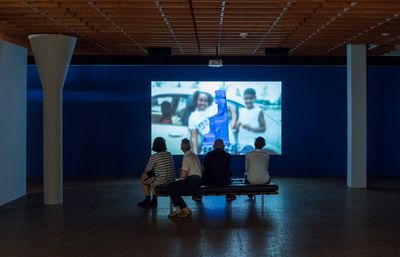
![Dineo Sheshee Bopape, Untitled (Of Occult Instability) [Feelings] (2016–2018). Exhibition view: We don't need another hero, 10th Berlin Biennale for Contemporary Art, KW Institute for Contemporary Art, Berlin (9 June–9 September 2018). Bricks, light, sounds, videos, water, framed napkin. Other works on view include: Jabu Arnell, Discoball X](https://files.ocula.com/anzax/Content/Reports%2FBerlin%20Biennale%202018%2FDineoSesheeBopapeBerlinBiennale_400_0.jpg)

